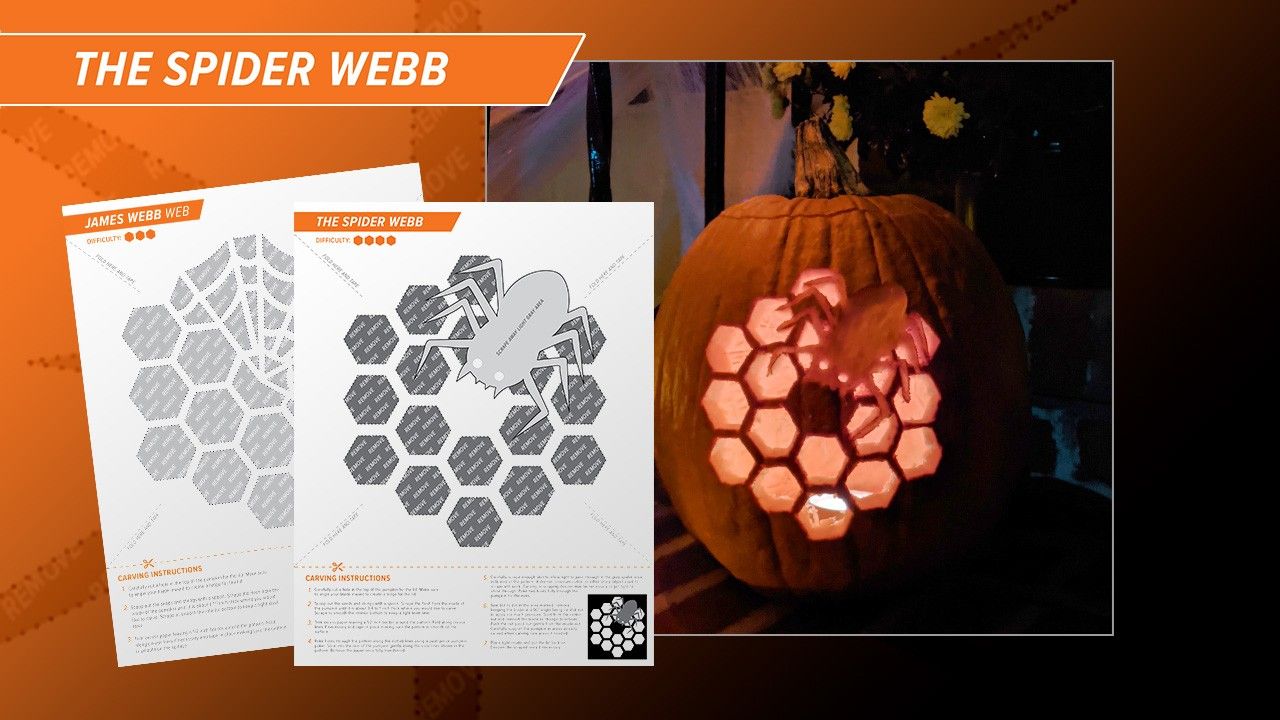1 min read
Halloween Pumpkin Webb Web and Spider Webb (Stencils)

Shall we carve a web or a Webb? No need to choose with these special Halloween-edition stencils featuring the James Webb Space Telescope’s distinctive hexagonal mirror. While the real Webb mirror is busy capturing invisible infrared light from distant stars, planets, and galaxies, these Web(b) stencils will help illuminate your neighborhood with an eerie orange glow. Note: Spider, spiderweb, and mirror are not to scale.
Find out more about Webb’s giant primary mirror and how it helps us study the universe.
Pumpkin Carving Materials and Instructions: Webb Web
(Difficulty Level: 3 out of 3)
- Carefully cut a hole in the top of the pumpkin for the lid. Make sure to angle your blade inward to create a ledge for the lid.
- Scoop out the seeds and strings. Scrape the flesh from the inside of the pumpkin until it is about 1 inch thick where you would like to carve. Scrape to smooth the interior bottom to keep a light level later.
- Trim excess paper, leaving a ½-inch border around the pattern. Fold or cut along crease lines as necessary to fit the shape of the pumpkin and tape in place. Make sure the pattern is smooth on the surface.
- Poke holes through the pattern along the dotted lines using a push-pin or pumpkin poker. Remove the paper once fully transferred.
- Saw dot-to-dot, perpendicular to the surface of the pumpkin, starting from the center of the pattern outward. Be careful not to apply too much pressure or the pumpkin could break. You may need to support partially-cut pieces in place while you are cutting. Push the cut pieces out gently from the inside.
- Place light inside and put the lid back on.
Pumpkin Carving Materials and Instructions: Spider Webb
(Same as above, except for Step #4; Difficulty Level: 3 out of 3)
- Carefully cut a hole in the top of the pumpkin for the lid. Make sure to angle your blade inward to create a ledge for the lid.
- Scoop out the seeds and strings. Scrape the flesh from the inside of the pumpkin until it is about 1 inch thick where you would like to carve. Scrape to smooth the interior bottom to keep a light level later.
- Trim excess paper, leaving a ½-inch border around the pattern. Fold or cut along crease lines as necessary to fit the shape of the pumpkin and tape in place. Make sure the pattern is smooth on the surface.
- Poke holes through the pattern along the dotted lines using a push-pin or pumpkin poker. Slide into the skin of the pumpkin gently along the solid lines shown in the pattern. Remove the paper once fully transferred.
Carefully scrape enough skin to allow light to pass through in the gray spider area indicated in the pattern. Poke two holes fully through the pumpkin for the eyes. - Saw dot-to-dot, perpendicular to the surface of the pumpkin, starting from the center of the pattern outward. Be careful not to apply too much pressure or the pumpkin could break. You may need to support partially-cut pieces in place while you are cutting. Push the cut pieces out gently from the inside.
- Place light inside and put the lid back on.
Try Other Stencils
Share
Details
Laura Betz
NASA’s Goddard Space Flight Center
Greenbelt, Maryland
laura.e.betz@nasa.gov
NASA, ESA, CSA, STScI
Leah Hustak (STScI)






























